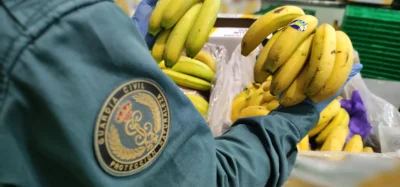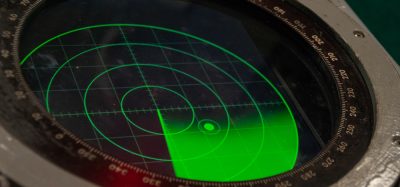Solubility of carbon dioxide in meat
Posted: 6 November 2006 | Marianne Jakobsen, Department of Food Science, Food Chemistry, The Royal Veterinary and Agricultural University, Denmark | No comments yet
Marianne Jakobsen, Department of Food Science, Food Chemistry, The Royal Veterinary and Agricultural University, Denmark
Modified atmosphere packaging (MAP) is widely used for the packaging of meat. In MAP, carbon dioxide (CO2) is primarily used due to its ability to inhibit the growth of a wide range of microorganisms (Farber 1991) and thereby extend the storage life of fresh meat. When high CO2 levels are applied, the concentration of CO2 in package headspace will decline during the first days of storage due to absorption of CO2 in the meat. CO2 dissolves in both muscle and fat tissue (Gill 1988), until saturation or equilibrium is reached.
Marianne Jakobsen, Department of Food Science, Food Chemistry, The Royal Veterinary and Agricultural University, Denmark Modified atmosphere packaging (MAP) is widely used for the packaging of meat. In MAP, carbon dioxide (CO2) is primarily used due to its ability to inhibit the growth of a wide range of microorganisms (Farber 1991) and thereby extend the storage life of fresh meat. When high CO2 levels are applied, the concentration of CO2 in package headspace will decline during the first days of storage due to absorption of CO2 in the meat. CO2 dissolves in both muscle and fat tissue (Gill 1988), until saturation or equilibrium is reached.
Marianne Jakobsen, Department of Food Science, Food Chemistry, The Royal Veterinary and Agricultural University, Denmark
Modified atmosphere packaging (MAP) is widely used for the packaging of meat. In MAP, carbon dioxide (CO2) is primarily used due to its ability to inhibit the growth of a wide range of microorganisms (Farber 1991) and thereby extend the storage life of fresh meat. When high CO2 levels are applied, the concentration of CO2 in package headspace will decline during the first days of storage due to absorption of CO2 in the meat. CO2 dissolves in both muscle and fat tissue (Gill 1988), until saturation or equilibrium is reached.
In MAP studies the effects of CO2 are usually related to the concentration of CO2 in the package headspace at the time of packaging and not to the concentration in the food, despite the fact that the gas that affects the food and the microorganisms is the one that dissolves in the water phase of the food (Devlieghere et al. 1998). The full preservative effect of CO2 will only be achieved if CO2 is added to the headspace in excess of the amount required to saturate the meat (Gill & Penney 1988).
Another concern is package appearance, when large amounts of CO2 are dissolved in the meat the consequential decrease in the gas volume surrounding the product can cause package collapse – known as ‘snug down’.
The absorptive capacity of the meat is related to biological factors such as pH, water and fat content (Gill 1988), but also to a large extent to the packaging and storage conditions e.g. temperature, CO2 partial pressure (p CO2) and headspace to meat volume ratio (Zhao et al. 1995).
Apart from the microbial effect, CO2 is also suspected to affect the chemical quality of the meat. A lowering of meat pH is a possible result of CO2 absorption, as produced carbonic acid dissociates to bicarbonate and hydrogen ions (Dixon & Kell, 1989). A lowering of meat pH is expected to affect the rate of oxidation processes e.g. pigment and lipid oxidation as well as the water holding capacity of the meat (Jakobsen & Bertelsen, 2002).
Project aims
Jakobsen & Bertelsen (2002) conducted a literature review on the packaging of meat in carbon dioxide. Reviewing the existing literature clearly identified the need for investigations on carbon dioxide solubility in fatty products. In the reviewed studies, the amount of absorbed CO2 varied from 0 – 1.8 L CO2 /kg meat depending on the applied packaging and storage conditions, which demonstrates the necessity of optimising these conditions with respect to the required amount of CO2. Two experiments were set up: Jakobsen & Bertelsen (2006) is a study of the effect of fat content and fatty acid composition on carbon dioxide solubility in pork meat; Jakobsen & Bertelsen (2004) is a study investigating the effect of both packaging and storage conditions as well as internal meat factors on carbon dioxide solubility.
Technologies used
It is more difficult to measure the concentration of dissolved carbon dioxide in food products than in a liquid medium, although methods do exist. CO2 absorption in solid foods is commonly measured by manometric methods. The principle of the ideal gas law is used on a gas impermeable compartment of constant volume. When the temperature is kept constant and pure CO2 gas or mixtures of CO2 and N2 are applied, changes in total pressure can be assumed to be the result of changes in the CO2 pressure. If gas mixtures including oxygen are used, sensors for the individual gases must be incorporated. The drawback of this method is that the equipment can only measure one sample per 24 hours (expected time lapse before saturation is achieved). Furthermore, it does not differentiate between CO2 absorbed in the product and gas evolved or produced by the product, and it does not account for the amount of CO2 that is naturally present in the product.
Instead, a titrimetric method was modified after Gill (1988). Samples that have been exposed CO2 under different conditions are transferred to a pair of flasks. One flask contains a strong acid evolving CO2 from the product which over night reacts with Ba(OH)2 in the other flask. Ba(CO)3 is precipitated and the remaining quantity of Ba(OH)2 is titrated against a standard HCl solution, directly in the flask. 30 samples can be titrated within a few hours.
The modified analysis has been successfully applied for fresh meat, cured ham and semi hard cheese.
Results obtained
The absorptive capacity of the meat is determined by increasing the following:
- CO2 partial pressure – increases absorption
- Headspace to meat volume ratio – increases absorption
- Water/fat content
- Storage temperature – decreases absorption in the water phase
- Storage temperature – increases absorption in the fat phase
- pH – increases absorption
For lean meat, Henry’s constant for water might be used as an approximation to predict the CO2 absorption in the meat. In Figure 1 Henry’s constants for water (Andersen et al. 1984) are plotted as a function of temperature together with an approximate correction for water content (78% water) and lower pH in meat (360 ml/kg for each pH unit (Gill 1988)) and experimental Henry’s constants for lean meat (2% fat, 78% water) (Jakobsen & Bertelsen 2004).
However, for fatty products the total fat content and level of unsaturated fatty acids becomes important as a large amount of the absorbed CO2 will be distributed in the fat phase. In Figure 2 the CO2 solubility increases with increasing temperature and increasing level of unsaturated fat. This corresponds well with the results of Gill 1988 and is attributed to the increased mobility/softness of unsaturated fats (Gill 1988).
Packaging and storage factors affect CO2 solubility extensively. The effect of CO2 partial pressure, volume ratio and temperature was evaluated in a packaging experiment (Jakobsen & Bertelsen 2004) together with some compositional parameters of the meat. If CO2 is applied in excess of the amount needed to saturate the product (volume ratio >2 (Gill & Penney 1988, Penney & Bell 1993) only the CO2 partial pressure is necessary to predict the total (water + fat) CO2 absorption. As a rule of thumb pCO2·1 LCO2/kg product will apply for estimation of the amount of absorbed CO2 in these products. The temperature dependence is less for meat than for water (Figure 1) owing to the fat fraction showing the opposite behavior to water, with increasing solubility at increasing temperatures.
However, for many products a volume ratio of less than 2 is sought. The level of the volume ratio then becomes very important, since CO2 absorption will reduce the CO2 partial pressure in the headspace at equilibrium more in a small gas volume than in a large gas volume and thus reduce the CO2 absorption. If a low gas volume of 0.5 of the product volume is applied, the CO2 absorption is markedly reduced compared to a volume ratio of 3, as seen from Figure 3.
Although significant effects on the internal meat factors pH, total fat content and fatty acid composition were found these are only expected to have minor practical importance compared to the external factors CO2 partial pressure and gas volume. pCO2 is by far the most important external factor for CO2 solubility in meat, but gas volume is also important even though it is often overlooked as an optimisation parameter.
Reviewing the existing literature, it was not possible to reveal a relationship between the lowering of meat pH due to CO2 absorption and decreased colour stability or increased weight loss.
Packaging in 100% CO2 does not result in any problems in relation to meat colour, provided that the total amount of residual O2 in package headspace is reduced to a minimum and packaging materials of low gas permeability are used, preventing O2 from re-entering the package.
While beneficial for inhibition of microorganisms, one drawback of high CO2 absorption is the formation of pores/fissures in the meat during cooking, due to rapid release of CO2 gas from the meat and an increased cooking loss (Bruce et al. 1996, Sørheim et al. 2004). Another question is whether high amounts of absorbed CO2 affect the taste. A preliminary study did not indicate so, but thorough research into the existing work on this subject has not been performed during this project.
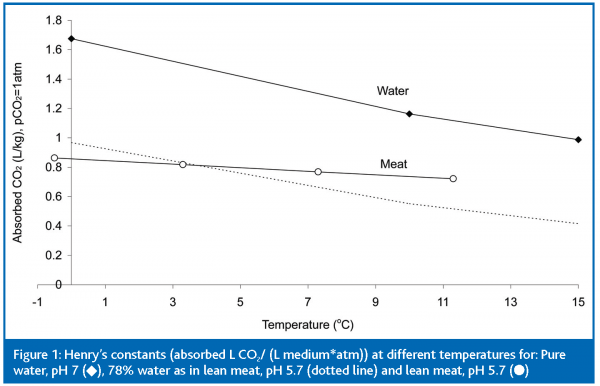

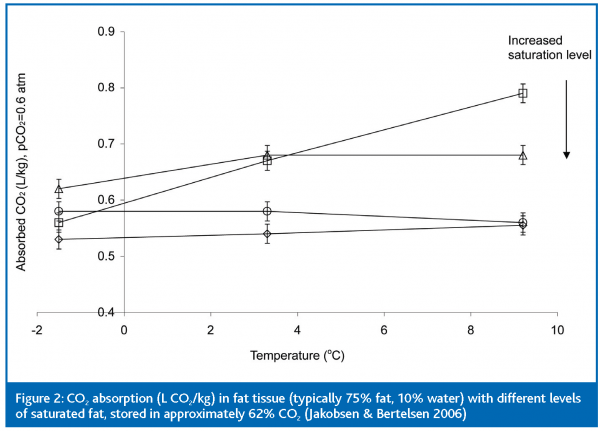

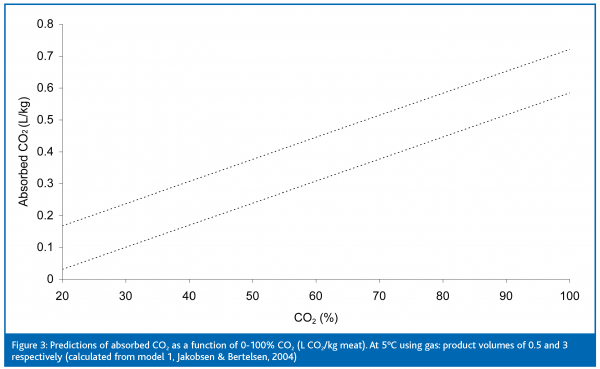

References
Andersen, E. S., Jespergaard, P. & Østergaard, O. G. (1984). Databog fysik kemi. 4thED., p. 52, F&K forlaget, Copenhagen, DK
Bruce, H. L., Wolfe, F. H., Jones, S. D. M. & Price, M. A. (1996). Porosity in cooked beef from controlled atmosphere packaging is caused by rapid CO2 gas evolution. Food Research International, 29, 2, 189-193.
Devlieghere, F., Debevere, J. & Van Impe, J. (1998). Effect of dissolved carbon dioxide and temperature on the growth of Lactobacillus sake in modified atmospheres. International Journal of Food Microbiology, 41, 231-238.
Dixon, N. M. & Kell, B. (1989). A review. The inhibition by CO2 of the growth and metabolism of micro-organisms. Journal of Applied Bacteriology, 67, 109-136.
Farber, J. M. (1991). Microbiological aspects of modified-atmosphere packaging technology – A review. Journal of Food Protection. 54, 1, 58-70.
Gill, C. O. (1988). The solubility of carbon dioxide in meat. Meat Science, 22, 65-71.
Gill, C. O. & Penney, N. (1988). The effect of the initial gas volume to meat weight ratio on the storage life of chilled beef packaged under carbon dioxide. Meat Science, 22, 53-63.
Jakobsen, M. & Bertelsen, G. (2002). The use of CO2 in packaging of fresh red meats and its effect on chemical quality changes in the meat: A review. Journal of Muscle Foods, 13, 143-168.
Jakobsen, M. & Bertelsen, G. (2004). Predicting the amount of carbon dioxide absorbed in meat. Meat Science, 68, 603-610.
Jakobsen, M. & Bertelsen, G. (2006). Solubility of carbon dioxide in fat and muscle tissue. Journal of Muscle Foods, 17, 9-19.
Penney, N. & Bell, R. G. (1993). Effect of residual oxygen on the colour, odour and taste of carbon dioxide-packaged beef, lamb and pork during short term storage at chill temperatures. Meat Science, 33, 245-252.
Sørheim, O., Ofstad, R. & Lea, P. (2004). Effects of carbon dioxide on yield, texture and microstructure of cooked ground beef. Meat Science, 67, 2, 231-236.
Zhao, Y., Wells, J. H. & McMillin, K. W. (1995). Dynamic changes of headspace gases in CO2 and N2 packaged fresh beef. Journal of Food Science, 60, 3, 571-575, 591.





